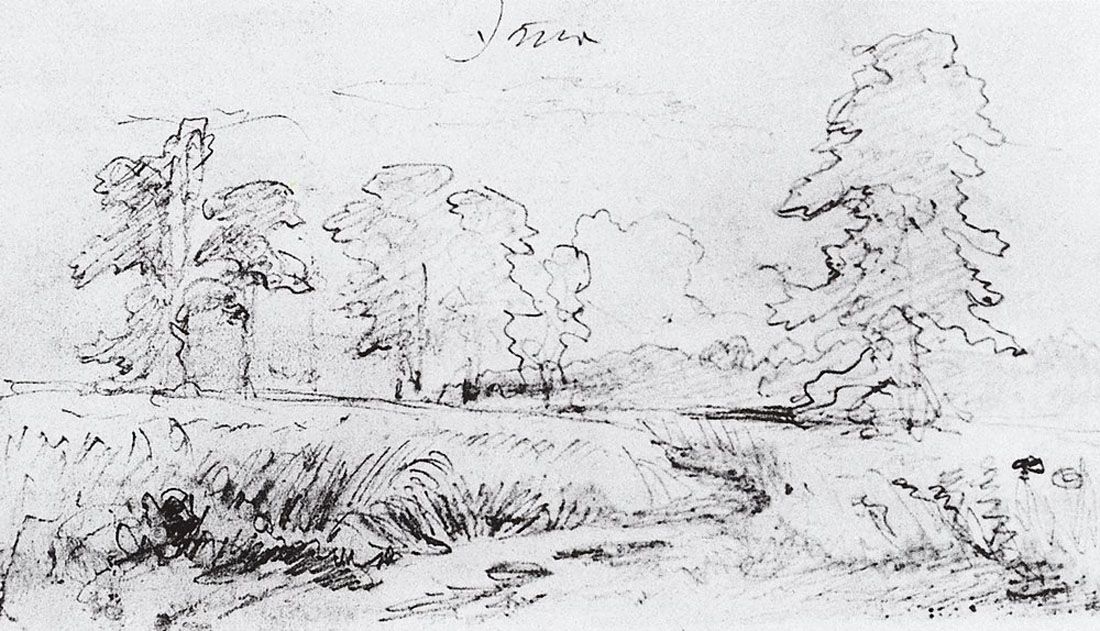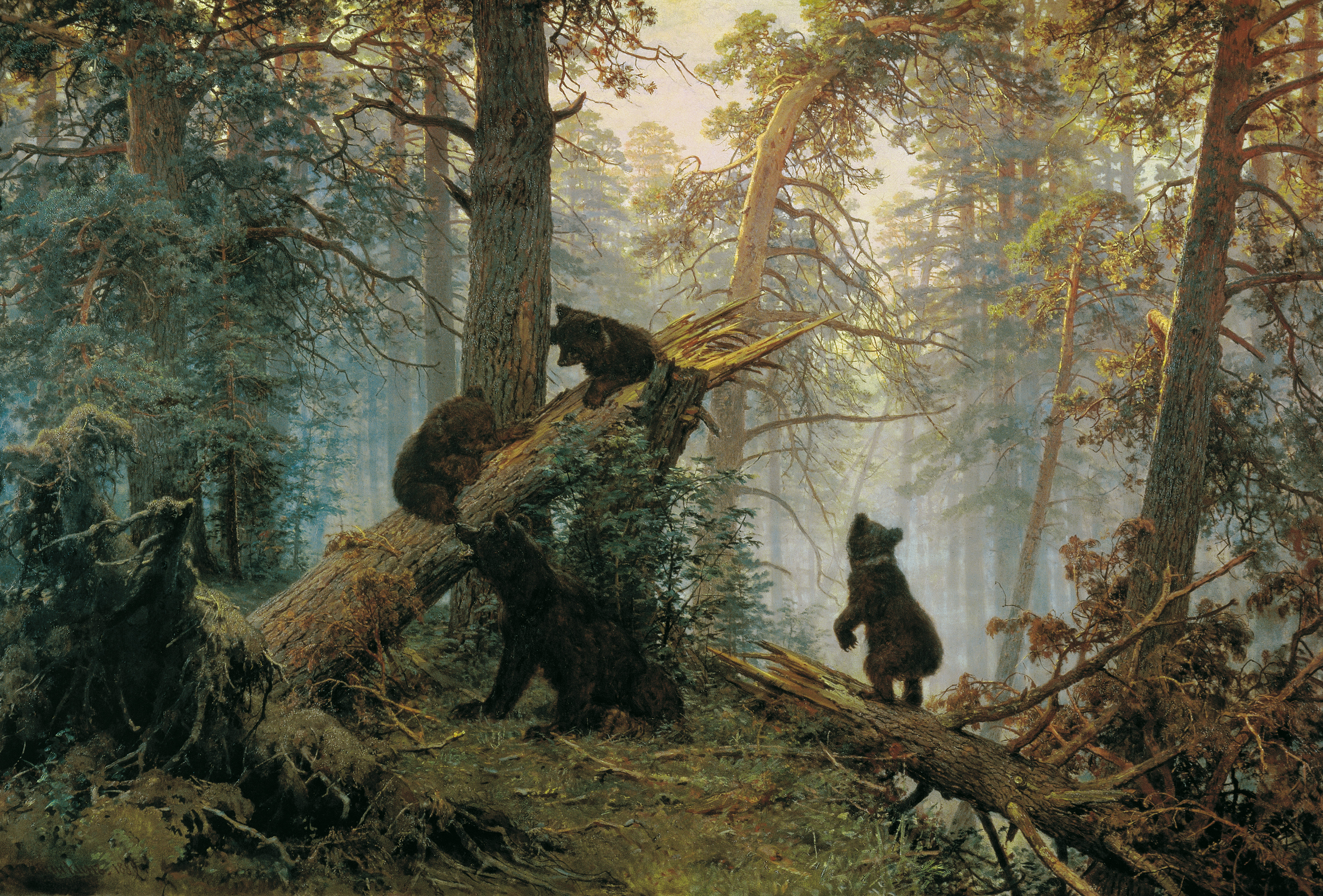|
Rye (Shishkin)
''Rye'' (russian: Рожь), sometimes ''A Rye Field'', is an oil painting of 1878 by the Russian painter Ivan Shishkin. It depicts a field of rye near the village of , west of Yelabuga in Tatarstan. It measures and is held by the Tretyakov Gallery. Shishkin was born in 1832 into a Russian merchant family in Yelabuga, then in Vyatka Governorate (today the Republic of Tatarstan), beside the Kama River some {{cvt, 200, km east of Kazan. As with many of his works, this painting draws from the countryside near his early home. It include two common elements from Shishkin's work: pine trees, and a road leading away from the viewer. Two earlier works in the collection of the Tretyakov, made by Shishkin in the 1860s, show travellers among fields of rye. The work is based on a pencil sketch of a field of rye near Lekarevo, which the artist made during a trip with his daughter in 1877, on which he wrote "Эта" (Russian for 'this one'). Notes on another sketch reveal his thought ... [...More Info...] [...Related Items...] OR: [Wikipedia] [Google] [Baidu] |
Ivan Shishkin
Ivan Ivanovich Shishkin (russian: Ива́н Ива́нович Ши́шкин; 25 January 1832 – 20 March 1898) was a Russian landscape painter closely associated with the Peredvizhniki movement. Biography Shishkin was born to a Russian merchant family in Yelabuga of Vyatka Governorate (today Republic of Tatarstan) and graduated from the Kazan gymnasium. Then he studied at the Moscow School of Painting, Sculpture and Architecture for four years. After that, he attended the Saint Petersburg Imperial Academy of Arts from 1856 to 1860 and graduated with the highest honours and a gold medal. He received the imperial scholarship for his further studies in Europe. Five years later Shishkin became a member of the Imperial Academy in St. Petersburg and was professor of painting from 1873 to 1898. At the same time, Shishkin headed the landscape painting class at the Highest Art School in St. Petersburg. For some time, Shishkin lived and worked in Switzerland and Germany on schola ... [...More Info...] [...Related Items...] OR: [Wikipedia] [Google] [Baidu] |
Tretyakov Gallery
The State Tretyakov Gallery (russian: Государственная Третьяковская Галерея, ''Gosudarstvennaya Tretyâkovskaya Galereya''; abbreviated ГТГ, ''GTG'') is an art gallery in Moscow, Russia, which is considered the foremost depository of Russian fine art in the world. The gallery's history starts in 1856 when the Moscow merchant Pavel Mikhailovich Tretyakov acquired works by Russian artists of his day with the aim of creating a collection, which might later grow into a museum of national art. In 1892, Tretyakov presented his already famous collection of approximately 2,000 works (1,362 paintings, 526 drawings, and 9 sculptures) to the Russian nation. The museum attracted 894,374 (visitors in 2020 (down 68 percent from 2019), due to the COVID-19 pandemic. It was 13th on the list of most-visited art museums in the world in 2020. The façade of the gallery building was designed by the painter Viktor Vasnetsov in a peculiar Russian fairy-tale style. ... [...More Info...] [...Related Items...] OR: [Wikipedia] [Google] [Baidu] |
Yelabuga
Yelabuga (alternative spelling that reflects the Cyrillic spelling: Elabuga; russian: Елабуга; tt-Cyrl, Алабуга, ''Alabuğa'') is a town in the Republic of Tatarstan, Russia, located on the right bank of the Kama River and east from Kazan. Population: Geography Climate History The former name of the city was Alabuga. Its history dates back to the 10th century, when a Volga Bulgar border castle, the so-called Alamir-Sultan castle was built by Bulgar Khan Ibrahim in 985 CE. The castle was built on the place of the legendary tomb of Alamir-Sultan (Alexander the Great "Macedonian"). The name 'Alabuga' originally referred to the tower of the castle, later the whole city was named Alabuga. The castle was later abandoned, and its remains are now known as ''Şaytan qalası'' (Shaytan's castle). In the second half of the 16th century, a Russian village was founded on the same spot. Administrative and municipal status Within the framework of administrative di ... [...More Info...] [...Related Items...] OR: [Wikipedia] [Google] [Baidu] |
Tatarstan
The Republic of Tatarstan (russian: Республика Татарстан, Respublika Tatarstan, p=rʲɪsˈpublʲɪkə tətɐrˈstan; tt-Cyrl, Татарстан Республикасы), or simply Tatarstan (russian: Татарстан, tt-Cyrl, Татарстан), sometimes also called Tataria (russian: Татария, tt-Cyrl, Татария), is a Republics of Russia, republic of Russia located in Eastern Europe. It is a part of the Volga Federal District; and its capital city, capital and largest city is Kazan, an important cultural centre in Russia. The republic borders Kirov Oblast, Kirov, Ulyanovsk Oblast, Ulyanovsk, Samara Oblast, Samara, and Orenburg Oblasts, the Mari El Republic, Mari El, Udmurt Republic, Udmurt, and Chuvash Republics, and the Bashkortostan, Republic of Bashkortostan. The area of the republic is . The unofficial Tatarstan motto is ''Bez Buildırabız!'' (''We can!''). As of the Russian Census (2021), 2021 Census, the population of Tatarstan was& ... [...More Info...] [...Related Items...] OR: [Wikipedia] [Google] [Baidu] |
Vyatka Governorate
Vyatka Governorate (russian: Вятская губерния, udm, Ватка губерний, mhr, Виче губерний, tt-Cyrl, Вәтке губернасы) was a governorate of the Russian Empire and Russian Soviet Federative Socialist Republic, Russian SFSR, with its capital in city Vyatka (now known as Kirov), from 1796 to 1929. In the governorate’s area were situated most parts of modern Kirov Oblast and Udmurt Republic. It was formed on territory of the historical lands of Vyatka Land, Vyatka ( la, Veticiae). Geography Vyatka Governorate was bordered with Vologda Governorate (to the north), Perm Governorate (to the east), Nizhny Novgorod Governorate, Nizhny Novgorod and Kazan Governorate, Kazan governorates (to the south), and Kostroma Governorate (to the west). Its area was approximately . Administrative divisions The governorate was divided into 11 uyezds: # Vyatsky Uyezd # Glazovsky Uyezd # Yelabuzhsky Uyezd # Kotelnichsky Uyezd # Malmyzhsky Uyezd # N ... [...More Info...] [...Related Items...] OR: [Wikipedia] [Google] [Baidu] |
Republic Of Tatarstan
The Republic of Tatarstan (russian: Республика Татарстан, Respublika Tatarstan, p=rʲɪsˈpublʲɪkə tətɐrˈstan; tt-Cyrl, Татарстан Республикасы), or simply Tatarstan (russian: Татарстан, tt-Cyrl, Татарстан), sometimes also called Tataria (russian: Татария, tt-Cyrl, Татария), is a republic of Russia located in Eastern Europe. It is a part of the Volga Federal District; and its capital and largest city is Kazan, an important cultural centre in Russia. The republic borders Kirov Oblast, Kirov, Ulyanovsk Oblast, Ulyanovsk, Samara Oblast, Samara, and Orenburg Oblasts, the Mari El Republic, Mari El, Udmurt Republic, Udmurt, and Chuvash Republics, and the Bashkortostan, Republic of Bashkortostan. The area of the republic is . The unofficial Tatarstan motto is ''Bez Buildırabız!'' (''We can!''). As of the Russian Census (2021), 2021 Census, the population of Tatarstan was 4,004,809. The state has stro ... [...More Info...] [...Related Items...] OR: [Wikipedia] [Google] [Baidu] |
Kama River
The Kama (russian: Ка́ма, ; tt-Cyrl, Чулман, ''Çulman''; udm, Кам) is a long«Река КАМА» Russian State Water Registry river in . It has a drainage basin of . It is the longest of the and the largest one in discharge. At their confluence, in fact, the Kama is even larger than the Volga. It starts in the |
Kazan
Kazan ( ; rus, Казань, p=kɐˈzanʲ; tt-Cyrl, Казан, ''Qazan'', IPA: ɑzan is the capital and largest city of the Republic of Tatarstan in Russia. The city lies at the confluence of the Volga and the Kazanka rivers, covering an area of , with a population of over 1.2 million residents, up to roughly 1.6 million residents in the urban agglomeration. Kazan is the fifth-largest city in Russia, and the most populous city on the Volga, as well as the Volga Federal District. Kazan became the capital of the Khanate of Kazan and was conquered by Ivan the Terrible in the 16th century, becoming a part of Russia. The city was seized and largely destroyed during Pugachev's Rebellion of 1773–1775, but was later rebuilt during the reign of Catherine the Great. In the following centuries, Kazan grew to become a major industrial, cultural and religious centre of Russia. In 1920, after the Russian SFSR became a part of the Soviet Union, Kazan became the capital of the Tat ... [...More Info...] [...Related Items...] OR: [Wikipedia] [Google] [Baidu] |
Swallow
The swallows, martins, and saw-wings, or Hirundinidae, are a family of passerine songbirds found around the world on all continents, including occasionally in Antarctica. Highly adapted to aerial feeding, they have a distinctive appearance. The term "swallow" is used colloquially in Europe as a synonym for the barn swallow. Around 90 species of Hirundinidae are known, divided into 19 genus, genera, with the greatest diversity found in Africa, which is also thought to be where they evolved as hole-nesters. They also occur on a number of oceanic islands. A number of European and North American species are long-distance bird migration, migrants; by contrast, the West and South African swallows are nonmigratory. This family comprises two subfamilies: Pseudochelidoninae (the river martins of the genus ''Pseudochelidon'') and Hirundininae (all other swallows, martins, and saw-wings). In the Old World, the name "martin" tends to be used for the squarer-tailed species, and the name "swal ... [...More Info...] [...Related Items...] OR: [Wikipedia] [Google] [Baidu] |
Peredvizhniki
Peredvizhniki ( rus, Передви́жники, , pʲɪrʲɪˈdvʲiʐnʲɪkʲɪ), often called The Wanderers or The Itinerants in English, were a group of Russian realist artists who formed an artists' cooperative in protest of academic restrictions; it evolved into the ''Society for Travelling Art Exhibitions'' in 1870. History In 1863 a group of fourteen students decided to leave the Imperial Academy of Arts in Saint Petersburg. The students found the rules of the Academy constraining; the teachers were conservative and there was a strict separation between high and low art. In an effort to bring art to the people, the students formed an independent artistic society; The Petersburg Cooperative of Artists (Artel). In 1870, this organization was largely succeeded by the Association of Travelling Art Exhibits (Peredvizhniki) to give people from the provinces a chance to follow the achievements of Russian Art, and to teach people to appreciate art. The society maintained ind ... [...More Info...] [...Related Items...] OR: [Wikipedia] [Google] [Baidu] |
Pavel Tretyakov
Pavel Mikhaylovich Tretyakov (russian: Па́вел Миха́йлович Третьяко́в; 27 December 1832 – 16 December 1898) was a Russian businessman, patron of art, collector, and philanthropist who gave his name to the Tretyakov Gallery and Tretyakov Drive in Moscow. His brother Sergei Tretyakov was also a famous patron of art and a philanthropist. Childhood Together with other Moscow businessmen he acted as the founder of the Moscow merchant bank (becoming one of its heads), the Moscow commercial and industrial company, some other large firms. He amassed a considerable fortune (4.4 million rubles), consisting of real estate (5 houses in Moscow), securities, money and bills. Collecting art Tretyakov started to collect art in 1854 at the age of 22; his first purchase was 10 canvases by Old Dutch masters. He laid down for himself the aim of creating a Russian National Gallery. In his collection Tretyakov included the most valuable and remarkable products, first of ... [...More Info...] [...Related Items...] OR: [Wikipedia] [Google] [Baidu] |






